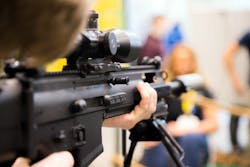6 best practices for mitigating active shooter threats in schools
School security involves the entire education community – including teachers, staff, parents, students, and law enforcement. However, administrators have the discretion and day-to-day responsibilities to make the largest impact. Everyone involved with our schools has a responsibility to help provide a safe environment in which teachers can instruct and children can learn without fear. School administrators have the ability to step up and make the decisions that lead to true security. It is important to take preventative measures now, before the next school shooting.
Schools are generally a safe place for students and staff, but it’s that sense of “it can’t happen here” that lulls us into accepting the status quo. A look at the shootings over the past few years demonstrates they happen on campuses both small and large. They have occurred in cities, suburbs, and rural areas. Gunmen kill on affluent and modest campuses. There is no way of predicting where the next school tragedy will occur.
In the United States, there are more than 130,000 public and private schools serving more than 50 million students daily. Recent acts of violence have led school administrators and public officials to reevaluate their security protocols in schools and on campuses.
We’ve seen it before with tragic events that seared the names of campuses into our minds —Columbine High School, Sandy Hook Elementary School, and the massacres at Marjory Stoneman Douglas High School in Parkland, Fla., that killed 14 students and 3 staff members, and at Santa Fe High School in Santa Fe, Texas, that killed 8 students and 2 teachers. The most recent shooting at STEM School Highlands Ranch in Colorado was carried out by two students who entered the school carrying handguns and other weapons hidden in guitar cases. They opened fire in two separate locations, killing one student and injuring eight.
These shootings continue to raise serious concerns and questions: How do we strike a balance between education and security? How do we change schools from being soft targets without making schools resemble prisons? Should teachers be armed? Should police be assigned to each school?
With these questions in mind, here are six best practices that all schools can implement to mitigate the threat posed by active shooters on their campuses.
1). Conduct Random Searches
According to the National Center for Educational Statistics, the latest study showed that during the 2017–18 school years, there were an estimated 3,600 incidents nationwide involving the possession of a firearm or explosive device at schools. In my opinion, there are more firearms on school campuses today that are not being detected.
A recommendation is for school administrators to implement random searches of students, lockers, vehicles, restrooms, stairwells, and other places where a weapon may be hidden. The idea is to keep students off balance and show that a policy of zero-tolerance for weapons will be strictly enforced.
2). Develop a Security Crisis Plan
Through careful planning, it is possible for schools to develop a quality security crisis plan that meets campus needs without breaking the budget. As a school security advisor, I work with school administrators, their staff, and local emergency responders to complete a thorough risk assessment to include the all hazards approach of all their schools and campuses. Every school and their campus is unique and has their own individual challenges, such as size, age, location, design or type of construction, and other factors. The assessment pinpoints critical areas of vulnerability and will identify the school security strengths, as well as any security weaknesses. The whole process is designed to reduce incidents and try to anticipate any emergencies that might occur on campus. The results of these assessments will be the initial phase to develop a course of action, a strategic plan, and a budget to secure each school and their campus.
3). Use SROs Whenever Possible
Schools around the country are soft targets, so we need be creative and use the resources that are available today that would stop weapons from coming into our schools. I highly recommend that all schools have an assigned police officer, often called a School Resource Officer (SRO). If unavailable, consider hiring off duty police officers and/or contract security officers that are certified and trained. These first responders can initiate action within seconds, not minutes when a crisis arises.
4). Train Teachers and Staff
While teachers should continue to concentrate primarily on their job of educating students, they can also play a critical role in helping to identify troubled students that need counseling or professional psychological intervention. Teachers (and staff, too) should take every threat and student tip of potential violence seriously and fully check up on each claim; never assume that any talk of violence is just an idle threat.
All schools should also have emergency/crisis plans and lockdown procedures in place; train staff, teachers, and students; hold safety/security drills with emergency responders; and practice responses to different emergency situations, e.g., active shooter. This also helps to keep parents and the community informed.
5). Harden Your Campus
Implementing a closed-campus policy is very important. The main campus entrance should be controlled using security window film or door security screens and electronic access through a video intercom system; allowing access to those who belong on campus like students, teachers, staff, parents, volunteers, and contractors, while keeping out the unwanted visitors: sexual predators, kidnappers, thieves, and others who have bad intentions. Correspondingly, it is wise to keep the landscaping trimmed and have security check outdoor places where a student might hide a weapon. All entry, exit, and classroom doors should be locked and monitored throughout the day.
All visitors need approval to enter the school building. He or she must be then escorted to the main office. Upon entering the office, visitors should be asked to produce a government-issued ID card that is swiped through a visitor management system. The system should check the visitor’s information against data in federal and state registered sex offender databases. According to the National Sex Offender Registry, there are more than 900,000 registered sex offenders in the United States. Once the visitor is approved to be in the school, a school staff member should provide a temporary identification badge that must be worn at all times on campus. Visitors should check out when leaving and return the badge.
6). Leverage Multiple Technology Layers
Any plan will undoubtedly include security technology, but no single security technology can protect a K-12 campus; true protection comes from many layers of security. It is imperative to test your communication/fire systems frequently: PA system, phones, radios, duress buttons, fire alarms, gunshot detection systems, and other devices. Metal detectors can help spot guns, knives, and other weapons at the school entry. Video surveillance cameras can create an added layer of security, giving school administrators and security officers a better idea of what is happening in and around their campus before, during, and after a crisis. Moreover, if the video is transmitted over a district network, it is possible to allow law enforcement personnel to view the cameras from their emergency command center and for the responding officers to view this from their vehicles.
In closing, school administrators should ensure they have a comprehensive safety and security plan in place. The plan should be a living document that is continually updated to meet the challenges of a particular school and campus. Seek out the assistance of a qualified security school expert, who can assist in risk assessment and plan creation. Protecting students, staff, and visitors on a school campus is a huge undertaking that requires planning, diligence, and ongoing attention.
About the Author:
Patrick V. Fiel Sr. is a national security advisor. He has over 40 years of experience managing security and law enforcement organizations. He has served as the public safety advisor for ADT Security Services, Executive Director of Security for the Washington D.C. Public School System and is retired from the US Army Military Police Corps. He has worked with over 15,000 schools providing security services and solutions. He can be reached at (910) 789- 4265 or at [email protected].
About the Author

Patrick V. Fiel, Sr.
Former Executive Director of Security for Washington, D.C. Public Schools
Patrick V. Fiel Sr., a national security expert with more than 40 years of experience in law enforcement and security management, is a retired member of the U.S. Army Military Police Corps. He is available to speak on risk assessments, active shooter preparedness and security best practices. He can be reached at (910) 789-4265 or [email protected].
